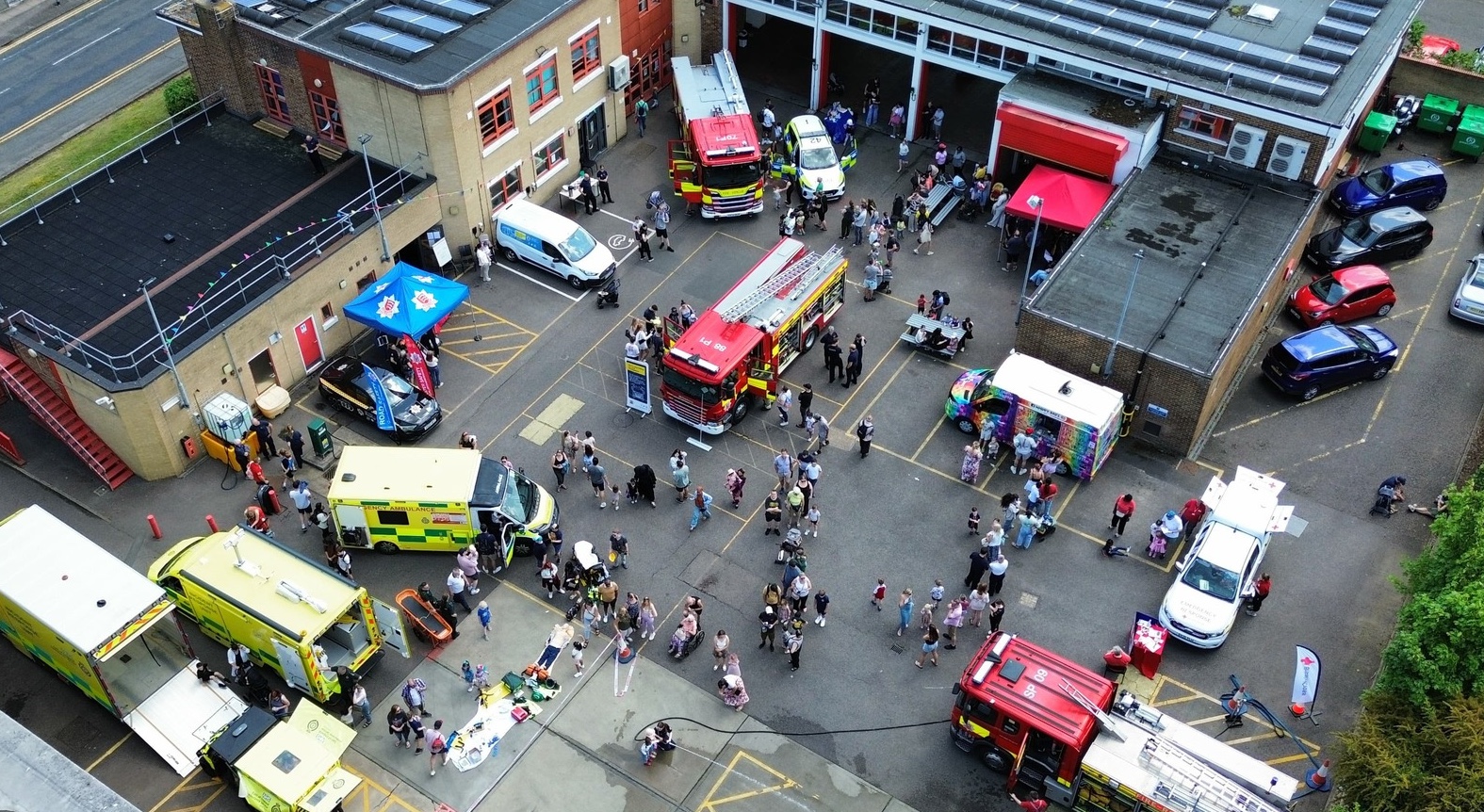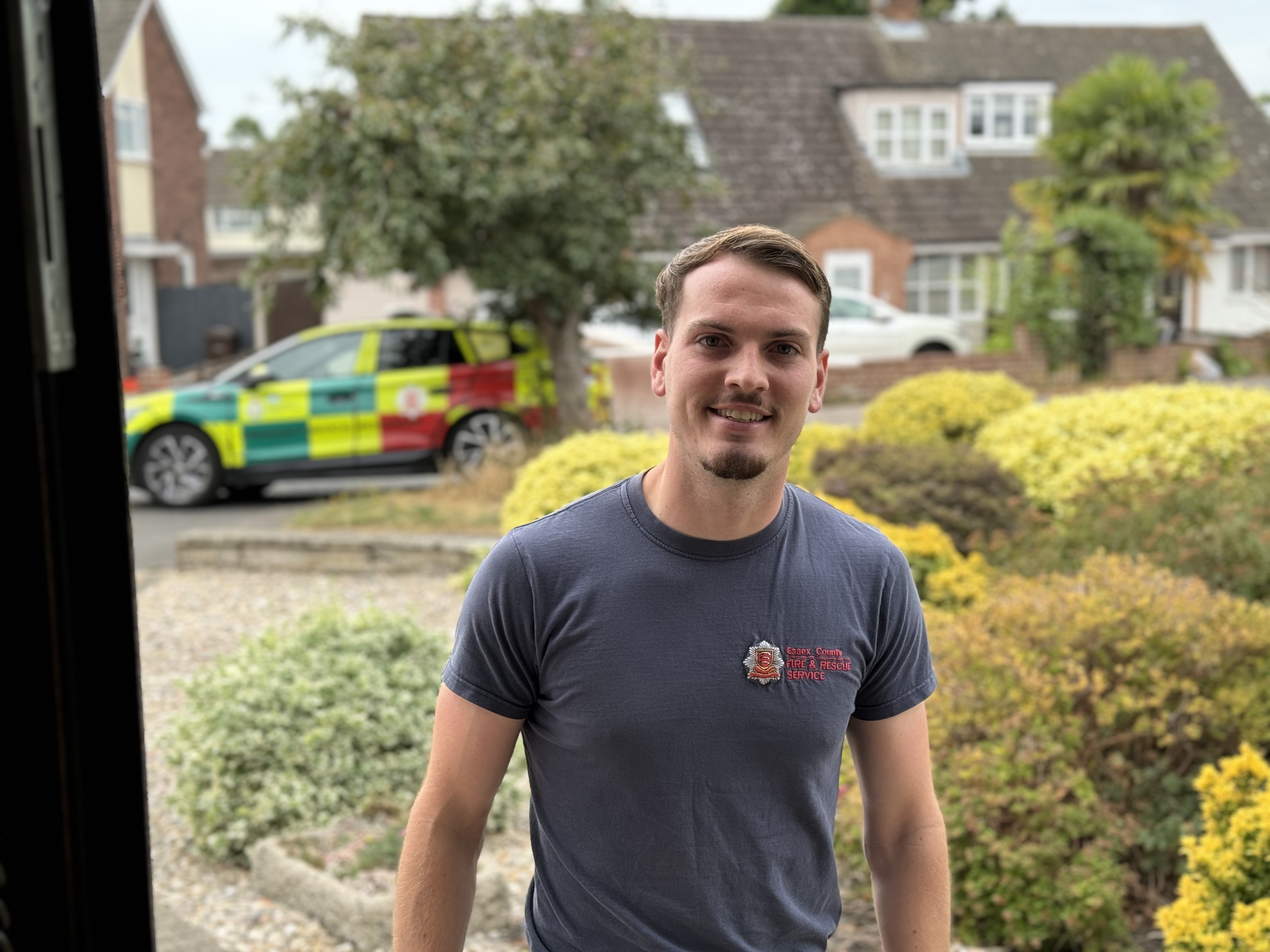Ancient Wheels of Fire – Article Two
Ancient Wheels of Fire – Article Two
The second article in the series will focus once more on four Essex fire appliances which served their respective fire brigades before the outbreak of the Second World War and as previously stated the appliances will be represented in the form of models to avoid the possibility of copyright infringement.
Epping Fire Brigade’s Mercedes
In Article One mention was made of an impressive Packard ex-military lorry that had been transformed into a fire engine by the indomitable Chief Officer Harold Woore. He was appointed to that post in February 1914, and it wasn’t long before he demonstrated his enthusiasm for all things mechanical. In July of that year, with his influence, it was decided to run a trial of a brand-new works fire engine constructed by Messrs Dennis of Guildford, the world renown fire engine manufacturer, with a possible purchase in mind. A few days before the trial the Epping Town Hall had been gutted by fire which might well have influenced the grandees of Epping to hold the said trial! The Dennis N Type, with its powerful 250 gallons per minute pump performed admirably and it was suggested that a meeting be arranged to discuss the introduction of a subscription to fund the purchase of the appliance which would replace the Brigade’s old manual fire engine. It was further suggested that the surrounding local parishes – sixteen in all - should be contacted with a view to joining the scheme. Ongar with its 26 parishes would also be invited to take part in the scheme. The intention to mechanise fell on stony ground when on 19 June 1915 the Brigade’s new horse-drawn steam-powered fire engine was tested for the first time on the Green opposite the Post Office. Obviously, this must have been a cheaper option, and the spectre of the loss of horses to the army prompted by the War was not apparent in 1915, but by the following May it had become a real problem. Consideration was given to converting the horse-drawn steamer so that it could be pulled to fires by a motor vehicle; the cost would be kept to a minimum as members of the Brigade, led by Harold, would do all work necessary. A suitable motor vehicle was purchased which ironically was a powerful 1906 German Mercedes 40/45hp car (London registration LC 6468) with a gigantic 6785cc engine capable of speeds of over 50mph. The conversion was duly undertaken successfully. The reliance on horses evaporated as the Merc’ was more than capable of hauling the steamer, which was demonstrated on 6 May 1917, when the Brigade received a call stating that the magnificent Copped Hall mansion was on fire. The Mercedes pulling the steamer set off on its first ever “shout” in the company of Harold and the only two available firemen, there was also a manpower shortage at the time! On arrival at the fire the three intrepid firemen could only manage to play two jets onto the blaze from an unreliable water supply. The result was predictable, the house was gutted.
There is very little evidence to suggest that the Mercedes had a long career with the Epping Fire Brigade, and its eventual fate is unknown. Nevertheless, it is worth noting that the Chelmsford Borough Fire Brigade embarked on a similar path when it too purchased a 45hp Mercedes in 1923 to pull one of its steamers, but not without some distain as disgust was felt by certain Councillors at the proposed purchase of a German car “made by those who had killed Englishmen”, (Chelmsford Chronicle 02.02.1923). However, it was the cheapest and simplest solution to the problem and the recommendation was adopted,
Wickford Fire Brigade
The Minerva touring car (London Central registration UV 3732) was purchased by the Wickford Volunteer Fire Brigade from Dixon’s Car Sales, Billericay in 1929. It had previously belonged to the Lord Lieutenant of Essex most probably Lord Lambourne or Sir Richard Beale Colvin. Minervas were prestigious Belgium cars made in Antwerp therefore it was not unreasonable that a car of that quality should have been acquired by a lord lieutenant. By coincidence the company also made fire engines. The intention was to convert the car into a small fire tender and this was achieved by an industrious member of the Brigade – Frank Dunmore who became the Brigade’s chief officer.
This pretty little motor tender seemed to be at the centre of a bit of a row within the parish of Wickford. On Friday 18 January 1929 it was reported that the Wickford Parish Council had made the decision to disassociate itself from the newly formed volunteer fire brigade owning to “certain irregularities”. All equipment and property (including the Minerva) used by the Brigade, and owned by the Council, was to be withdrawn and the Council would form their own brigade. The members of the existing brigade felt that there had been a misunderstanding and were willing to work with the Council as they had, “already done good work and had received commendations”. When asked what would happen if the present position continued, and the Council had their own brigade, the speaker said: “We shall still carry on as at present. We shall run as a contracting brigade”, (Chelmsford Chronicle 18.01.1929). After a degree of toing and froing it was apparent that an agreement was arrived at by which the word “volunteer” disliked by the Council was removed and the title simply became Wickford Fire Brigade. The Brigade was eventually subsumed by the Billericay Fire Brigade and the little Minerva was lost to posterity.
Tilbury Fire Brigade
In several ways this 1928 Halley pump escape (Chelmsford registration BVX 395) is a bit on an enigma, which will be explained shortly. Halley Industrial Motors Ltd of Yoker, Glasgow started producing steam lorries as early as 1901. By the start of the Great War Halley was producing a wide range of petrol-driven lorries up to four tons. It was predictable that the firm was invited, by the War Office, to manufacture lorries for the army. However, the firm had limited production capacity and was only able to manufacture a relatively small number of vehicles – only 250 by May 1916. These vehicles were driven south to the Kempton Park Reception Park, Middlesex (now Surrey). The War Office believed that Halley Motors would be of more use producing shells rather than lorries, so production was switched to munitions. Naturally after the war there was little need for a high volume of munitions and the firm resumed production of motor vehicles. However, with the market being swamped by the influx of refurbished army surplus vehicles, sold at ridiculously low prices, Halley found it difficult to compete. The firm soldiered on until 1931 when it was rescued, for a time, by the North British Locomotive Company. Sadly liquidation struck in 1935 when a buyout took place by the well-known Albion Motors Ltd another Scottish manufacturer.
Halley had a good deal of success producing fire engines which were used by several Scottish fire brigades. Curiously it is worthy of note that two such machines also could be found stationed in Essex in the late twenties and thirties, the one in question and a Halley-Simonis, belonging to the Dagenham Fire Brigade, (Chelmsford registration VW 6922).
The Tilbury Halley poses a conundrum as it was widely thought to be the last fire engine produced by the company however, when undertaking research for this article, Historic Roadways informs us that the last Halley produced was purchased by the Clydebank Fire Brigade.
By the start of the war Tilbury Fire Brigade and other local brigades, had been incorporated into the Thurrock Fire Brigade which poses further questions. A photographs dated 1942 held in the Essex Fire Museum archive has a handwritten caption stating that the machine carried a relatively unusual Clydesdale pump. The image also shows the Halley, along with its crew in NFS uniforms, still in what appears to be its original red livery with a glimpse of a NFS identification code applied to its superstructure, both of which are correct as not all prewar vehicles were painted “NFS grey” and appropriate NFS coding would have been applied then. But strangely the Halley still bears its fire brigade markings i.e., Thurrock Fire Brigade and the Council’s civic coat of arms which should have been erased. Further, there is no white outlining visible on the bodywork of the machine. A possible solution to these puzzles possibly could be that the date of the photograph is wrong, instead of 1942 the date might well have been 1945. An Order issued on 1 May 1945 required the removal of white outlining from NFS vehicles, but this still does not explain why it still carried its Thurrock Fire Brigade markings which should have been erased when the NFS was formed in 1941. Any solutions to this conundrum would be gratefully received!
Walthamstow Fire Brigade
We now move from one of the most enigmatic machines in the county to one of the most impressive. In 1912 Walthamstow Fire Brigade acquired two brand new fire appliances, a pump escape in June (Essex registration F5675) and a pump in December, (Essex registration F6185). Both machines were purchased from Commercial Cars Ltd commonly known as Commer. This article will focus on the former.
In May 1912 the Commercial Motor Users’ Association held its sixth annual parade and competition of self-propelled vehicles at Grosvenor Road, London. When the judging started the array of vehicles snaked its way from Vauxhall Bridge to Lambeth Bridge. A vehicle that attracted great attention was a fire engine “which was ingeniously contrived to convey a pump and first aid outfit”, (Belfast News Tuesday 28.05.1912). This fire engine had been purchased by Walthamstow and exhibited at the event before it went into service with the Brigade. Shortly before this event the appliance had been displayed at Walthamstow when in April Messrs Henry Simonis & Co a manufacturer put on a display of firefighting equipment at Walthamstow:
Probably the most comprehensive demonstration of motors for firefighting purposes which has yet been held by a British manufacturer was that which a number of fire-brigade chiefs and Government officials were invited to witness, at Walthamstow, on Friday last, by Messrs. Henry Simonis and Co. A range of five first-class machines, each representing a different type, was shown, and some of them were operated so as to prove their capabilities to perform the service required of them. All these units will shortly be delivered to their respective purchasers, (Commercial Motor Archive from the original printed 25.04.1912.).
This provided Simonis an opportunity to exhibit their equipment which they had installed on the Commer pump escape. The article went on to outline the attributes of the new Walthamstow appliance:
The largest machine yet. built, jointly, by Messrs. Simms and Commercial Cars, Ltd., is the new 70-80 hp motor pump for the Walthamstow Fire Brigade. The engine has four separate cylinders, each 140 mm. in diameter, and a piston-stroke of 190 mm. It is capable or developing from 70 hp to 80 hp at its maximum speed of 1400 rpm. The usual Commer-Car practices have been followed in the general construction. The three-stage centrifugal pump is driven through gears of equal size, and it may be controlled from the back of the machine. The pump's capacity is 450 gallons per minute, and during the demonstration, it showed its ability to throw a thin jet against a pressure of 120 lb. per square inch. It also carries a first aid apparatus of 30-gallons capacity which may either be operated by the pressure of compressed gas or coupled, through the medium of a three-way fitting, to the hydrant. (Commercial Motor Archive from the original printed 25.04.1912.).
Seemingly, Walthamstow was following in the path of its close neighbour, the London Fire Brigade, in a quest to replace its fleet of horse drawn appliances with more efficient motor-driven machines. Commer was one of a group of motor manufacturers, including Dennis of Guildford and the Leyland Company, who had recognised the potential of manufacturing motor fire engines.
There is no doubt that in 1912 this machine, weighing in at around 4.5 tons, was well ahead of its time. It was the most powerful car (as it was referred to) yet made. Its four-cylinder engine could propel it at speeds in the region of 50 miles per hour. Its pump was able to direct a jet of water over 200 feet into the air and at great force more than capable, when necessary, of knocking walls down with six strong men needed to handle the hose at full blast. Fighting fires at night was made easier by the addition of a bonnet-mounted searchlight a feature which the Brigade’s other Commer also boasted. For reasons known only to the Brigade the choice of colour, for both Commers, was vermilion a much brighter and vivid shade of red than was the norm. This was a very impressive machine with little to rival it both in the county and further afield. Walthamstow Urban District Council must have been suitably impressed by the pump escape as it purchased the second Commer later in the year but inexplicably this was not replicated by other brigades in the county as Dennis and Leyland machines seem to have been pre-eminent.


